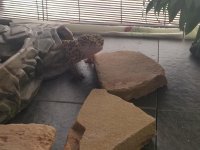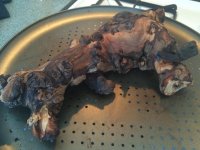Updates: Old leo, New home / Juvenile ate sand (impaction risk)?
Gabby (15+ year old Mack Snow, male)
As some of you know, I gave Gabby a new tank, and some new amenities. Check out the pictures below!



He's been so happy with the new home, that he's taken a liking to not only his sand hide, but his moist hide and his cork bark! He spends more time inside his cork log than anywhere else. Only problem is getting him used to the new arrangement of his food bowl. He's still trying to figure out where and how to get food.
Cornbread (1 year old Tangerine, male)
I have a stressful update for my little guy. Lastnight I took out one of his slate tiles (he had pooped on it instead of his usual spot). Underneath his tile there is sand, specifically calcium sand. I know, I know, this is not good, but it is not exposed unless I remove the slate tile.
When this happens, I place Cornbread in a temporary container. This time, I let him stay in his cave, hoping he would not come out... No more than 30-60 seconds after I stepped away, I came back to find him
nose-deep in sand, eating it! I had to wipe some clumps of sand from his mouth and urge him away. I fed him a cricket, hoping it would digest / mix with the sand and lead to less impaction...right?
I have no idea how much he consumed, but I got there fast as I could, and it was only a minute of time. I will watch Cornbread carefully over the next few days and see if he passes it. I never intended this to happen, but I learned my lesson on keeping him in the tank when sand is exposed. I hope my little guy is okay.








